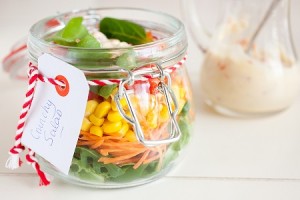

We all know we should never go to a grocery store without a list—and that we should never, ever (well, maybe, if there’s a really good reason) deviate from it. What many of us really don’t know is exactly how supermarkets trick us into parting with our money.
You know how it is. You go in for bread, milk and toilet paper. You come out with “fresh” (reheated from frozen dough) bread, some pretty flowers, cake that was on sale and a copy of Vogue because The National Enquirer makes too much sense. Also some toilet paper—but you forgot the milk. So you go back for the milk and you get it, along with the new type of instant coffee and the cereal you sampled.
Everything about your supermarket is optimized to make you spend money that you didn’t plan on spending, and even that you don’t really have to spend. Here are some of their best, most common tricks—and how to be aware of them so that you can avoid falling into the trap.

22 Sneaky Tactics
- Warm colors on the outside—like a brick façade—bring you in. Cool interior colors, like blue, encourage you to spend more.
- That music you hear? Is designed to slow you down because the more time you spend it a store, the more money you spend. And if it’s classical music, you’re more likely to buy expensive stuff. (To get in and out, wear headphones and listen to fast music.)
- The bigger your shopping cart, the more stuff you buy, more easily. Want to limit your purchases? Use a hand basket.
- And the more food you buy, the more you’ll eat. Economy sizes of dish soap, detergent and toilet paper are one thing: you’re just not going to start using twice as much. But if you’ve gone from buying a 6-pack of soda once a week to a 12-pack of soda once a week, chances are, you’ve probably doubled your soda consumption. And increased your waistband. And your risk of diabetes.
- The floral department is near the entrance because the fragrance puts you in a good mood. Just being cheerful encourages us to spend money.
- That’s why the produce department is at the front of the store, too. The pretty, appetizing colors of fruit and veggies put you in a good mood so you want to buy food. If you take advantage of that moment and load up on produce, all those healthy items in front of you as you continue your shopping trip can serve as a reminder of your health-building efforts and hopefully put the brakes on sabotaging impulse buys.
- And the bakery and deli departments. Food smells make us hungry and then hungrier, the more we want to eat. Which means we buy more.
- Sample stations don’t just expose you to new products, they slow you down. And if you enjoyed the sample, chances are, you’ll buy it. Or something else to reciprocate the “gift.”
- Likewise, the closer a product is to your eye level, the more the store wants you to buy it. Better stuff and better-priced stuff are usually above eye-level or near the floor. But be careful. That’s because…
- The closer a product is to your kid’s eye level, the more the store wants your kid to nag you to buy it. All the cereal-shaped sugar is at kids-eye-level.
- If it’s on the end cap of an aisle, the manufacturer really wants you to buy it. So much so, they’ve paid money to the store to put it there.
- If you see something you like in the deli counter, check if it’s also in the dairy case. If it’s there, it’s probably cheaper. You’re paying extra for slicing and wrapping.
- The hot pizza in your store’s deli is probably the store-brand pizza in the freezer case, and for a lot more money per slice. Don’t take the risk that it isn’t handmade goodness, and just move on.
- Likewise, at the fish counter, if it says “previously frozen” in small type, you can find it in the freezer case for less. Bonus: it may be an especially good deal if it’s in larger amounts, and of course, you don’t have to use it right away.
- Just because a product is in your store’s circular, doesn’t mean it’s on sale. It may very well be full price.
- If you see something sold at 10 for $1 (for example), make sure you’ll actually use 10. They’re planning to make their money on bulk purchases. (Zolpidem)
- Likewise, check to make sure that the sale item you think you’re buying is actually the item on sale—rather than the full-price version right next to it.
- The most profitable items in a store are in the checkout line. They are also often among the least healthy and most tempting—especially to children, and manufacturers count on parents wishing to appease a screaming child to avoid embarrassment.
- When you sign up for a Valued Customer card, you hand the store genuinely valuable tracking data about your spending habits in exchange for an occasional deal on—usually—processed food.
- We tend to remember only the prices of milk, bananas, eggs and bread. Which means we don’t really know what all the other items should cost.
- Most of us buy 80% of our groceries week after week, so keep your receipts and look at the prices. That way, you’ll know when to take advantage of sales.
- Supermarkets deliberately make their checkout lanes narrow, with very little shelf space, so it’s hard for you to put something aside at the last moment.
You’d think that with all these sneaky tactics, that the stores would be turning large profits, right? Well, you might be surprised to know that your local supermarket makes about 1.5% profit—that’s it. Just so you know.
Where does the rest go, you ask? To the major manufacturers who turn food into processed poison, and the advertisers who convince you that you can’t live without it. But you can. And better.
How to Stretch Your Budget Further
Now that you know the tricks supermarkets use to get you to spend your money on things you don’t want, don’t need, and aren’t good for you, here’s how to stretch your money. You can use the savings to buy better-quality food, like pasture-raised meat and eggs, hormone-free milk, and sprouted whole grain bread. There’s a reason these items are (sadly) often more expensive: they taste better and are better for you! Make the most of them and save a surprising amount of money:
- Fresh bread in those attractive paper bags stays fresh longer if you put it in an airtight plastic bag when you get home. Since your bread won’t go bad before you can eat it, you can buy better bread, like sprouted whole grain bread, which is far more nourishing than regular white or wheat bread. Regular wheat bread is often white bread that has been colored brown—at best with molasses and at worst with possibly carcinogenic caramelized sugar.
- If you see something you want in the bakery or meat departments and the expiration date is tomorrow, ask them if they’ll mark it down for you tonight. They probably will.
- Similarly, scratched and dented goods, such as canned food, shampoos, etc., can be had at significant savings.
- Imperfect, blemished fruits and vegetables are often amazing bargains, particularly if you’re going to use them in the next day or so. Remember: it doesn’t have to be pretty to be delicious and nutritious.
- If you’re concerned about the cost of buying organic, you can save money by limiting those buys to an as-needed basis. Click here to read more about When to Go Organic.
- A good sale is about a 50% price cut. It is mathematically the same as a 2-for-1 special, but the latter is only worth it if you can use it before the expiration date without betraying your health.
- Buying in bulk is often a better deal, especially if the food is not packaged (such as products in bins sold by weight). However, this is not a set-in-stone rule. Check unit cost.
- Want local or hormone-free milk? Chances are, your local convenience or drug store has it a better price than your grocery store.
- However, loyalty can sometimes pay off. Your grocery store will do a lot for you—for free—if you just ask. This includes special-ordering things for you. Need a special order on a regular basis? They can do that, too.
- The butcher counter, while seeming to be an indulgence, can be a surprising source of tailor-made orders at no extra cost.
- They can bone or tenderize meat or fish, skin fish or chicken and dredge them in seasoning, trim the fat off meat and marinate it, and special-order things for you.
- On a per-pound basis, large cuts of meat are cheaper than small ones. You can ask the butcher to cut them up into smaller portions, the freeze for later use. Spend the savings on better-quality meat.
- Don’t be taken in by marketing. “Angus” isn’t great beef, it’s just a breed. Look for the USDA quality grade: prime (which is rarely found in grocery stores, and tends to be the highest in fat), choice, select, and finally, standard. You can find really great meat at your farmer’s market: hormone- and antibiotic free, and pasture-raised. Make sure that if you go at the end of the day, ask for discounts.
- Supermarket meat departments usually mark down meat between 8 and 10 AM. This is the time for bargains. Find a large roast that’s too big for your needs but it’s a great bargain? Ask the butcher to cut it up for you. When you get home, freeze the portions separately.
- Food safety is a growing and significant concern, especially when it comes to ground meat, which can contain the least desirable trimmings from many, many cattle. See a great bargain on some pasture-raised chuck roast or sirloin but you’re jonesing for a great hamburger? Have the butcher grind that meat into hamburger. You get terrific ground meat—and your risk of food-borne infection has taken a nose-dive.
To learn which foods you should buy at the supermarket (and 5 foods to never eat), click here.
Comments 21
Leave a Reply
You must be logged in to post a comment.




Shank you, although in the UK, it was a very informative article thank you!
All of your info seems to be U.S – based. I am in the UK where things are expressed differently. ie granary bread. Is this genuinely whole wheat and nutritious?
Hi, Gentlejohn. While granary bread is generally a good choice, it is it is still a good idea to check the label or ask the baker about the ingredients. Like any bread, it is either mixed wholemeal and white flour or 100% wholemeal, and we of course recommend the latter.
In general, the foods in our lists are actually collected from around the world (and available in the UK), but lesser known to many. They were selected because they are less mass-produced and therefore relatively unmanipulated and more nutritious and supportive of health and healthy weight management. I encourage you to take advantage of our shopping guide https://www.trimdownclub.com/where-to-buy-UK; one of the sites, http://www.goodnessdirect.co.uk, offers nice explanations of their foods. Regular supermarkets such as Tesco, Asda, and Waitrose are increasingly carrying these items as health-conscious consumers are increasingly requesting them; Holland and Barrett carries even more, of course, and Whole Foods Market even more.
I totally agree with arianpierce in the comment made 10sept . Please put the list of 5 donts on our front page to remind us all, thanks.
Hi,
Just started your program, bad timing with Christmas looming, so with that in
Mind, I might stray a bit over the holidays. One thing I’ve noticed about the
Menu’s is lots of nuts. I’m not allergic to nuts, but too many can upset my
Tummy. Is there something I can substitute to avoid unpleasant problems.
I’m male, 64 going on 65, obviously well over my desired weight, fairly active
As my dog insists on two good walks each day, with one arthritic knee, a kidney
Ailment in remission and a slight asthma problem. Cholesterol is under control
With medication. I’m wondering if perhaps a different menu might be more appropriate for me. Can you help please. But on a good note, only been on this
Diet for two weeks and already lost 3 pounds in weight, that’s brilliant, thank you.
Hi, upontop.lineham, and welcome. A high-stress period is actually the best time to join, because you can start thinking about how you can make each situation a little better.
Regarding your menu, it would be best for you to use the personal version of the Menu Planner (the right-most option in the application area here – https://www.trimdownclub.com/menu-planner) so that you can select the foods that work for you. In the food lists, you will guided by our color-coding system, whereby the healthiest foods are in the lighter blues.
Best of all, you will get a sense of portion sizes, which you can use while you’re partying. The most important thing is to remember that occasions are about bonding, not food – changing your mindset may take a while, but it can happen!!
would be nice if there was a shopping list premade for the weekly menu.
rick z
Could you please tell me if you are connected to Mike Geary? I have been receiving emails trying to sell me products ever since I signed up with you.
Thanks
Hi, gaynor. We are not really connected to Mike Geary, but we do pass along his advice to our Clubmembers. His materials are offered in response to the many requests we have gotten for guidance in buying products, and after reviewing the different types, his came out as being the most consistent with research and quality parameters.
Hi
Firstly, let me just say that my initial impressions about this program seems to be gender specific-female.
The questions in the initial steps seems to point in that direction together with other observations. So my first question would therefore be, being male, is this program suitable for me?
I am pre-diabetic and have elevated levels of cholesterol. Are there foods that help to improve your insulin sensitivity and also is the IC-5 ( one of the links took me to a presentation trying to sell this product) supplement any good?
Thanks
Hi, Gony. The program is intended for both genders and is based on principles of diabetes management – so no worries there. The IC-5 product contains ingredients show in scientific studies to be supportive of metabolic health relevant to diabetes as well.
Nice article! Thank you !
Great by arianpierce on 9/14
Please provide a short cut to the 5 foods we should not eat that does not bring us to something for which we have not asked.
Regards
Jim
Hi. I just listened to the 5 things to never eat. And I didn’t get artificial sweetener, although I agree it should be on there. The thing I got instead was CORN. The Genetically Modified corn. Which you did say was hidden in a lot of products such as sugar, sweeteners and other foods. I have tried carefully for a couple of years to steer clear of High Fructose Corn Syrup. I enjoyed your presentation and eager to use your program. Thanks so much for offering this. I don’t really know how your offer got to my email but so glad it did. I tried weight watchers, but they met at a time hard for me to attend and they recommended substances I knew were harmful to you such as artificial sweeteners.
Hi, Larry. Sprouted whole grain(such as Ezekiel by Food for Life) is considered the gold standard, but the 100% whole grain types you find at health-oriented shops such Whole Foods Market and Trader Joe’s (especially their name brands and those indicating non-GMO) are generally just fine. Be sure to check the label to be sure you don’t get anything with hydrogenated fats, mono- or di-glycerides, or palm oil.
What are the healthy versions of Tortilles you can buy?
Hi, Leslie, and welcome. The best thing for you would be to use the Menu Planner application (in Apps above) to have your own personal menu built based on what you can and cannot eat. There is a video tutorial included, if you wish.
Is there an area to see what foods are acceptable and when you can make substitutions. For example: I don’t drink milk and bread is a trigger food for me and I’d rather stay clear of it. As a result the seven day menu provided causes some complications. This is my first day reading about the program and I’m not sure where to go or where to start!
Hi, arianpierce. I have forwarded your suggestion to our development team. In the meantime, the following are the five foods:
1. Regular “whole” wheat bread
2. Regular margarine
3. Artificial sweeteners
4. Processed soy products
5. Regular preserved orange juice
Note that these are just examples of processed and/or refined foods with artificial ingredients and/or additives – you don’t necessarily need to worry about the specific foods themselves, just know that there are almost always better versions out there, and upgrades can make a big difference.
Good tips…..thanks!!
Can we please be just told and reminded of the 5 foods to not eat. This link takes you back to a very long presentaion that we already listened to purchase the program. It should always be on top of screen we set up our food list for the week.